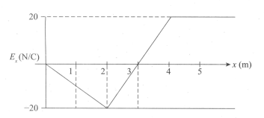EASY
NEET
IMPORTANT
Earn 100
A graph of the component of the electric field as a function of in a region of space is shown. The and components of the electric field are zero in this region. If the electric potential is at the origin, then the potential at is


(a)
(b)
(c)
(d)
50% studentsanswered this correctly

Important Questions on Electrostatics
EASY
NEET
IMPORTANT
EASY
NEET
IMPORTANT
MEDIUM
NEET
IMPORTANT
MEDIUM
NEET
IMPORTANT
MEDIUM
NEET
IMPORTANT
MEDIUM
NEET
IMPORTANT
An electron travelling in a uniform electric field passes from a region of potential to a region of higher potential . Then

EASY
NEET
IMPORTANT
Three concentric conducting spherical shells carry charges as follows: on the inner shell, on the middle shell and on the outer shell. The charge on the inner surface of the outer shell is
EASY
NEET
IMPORTANT
